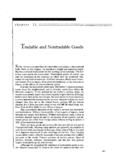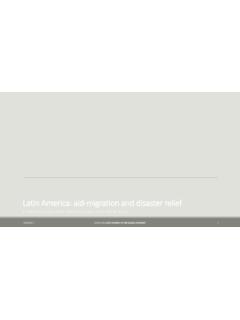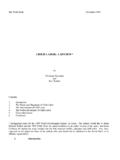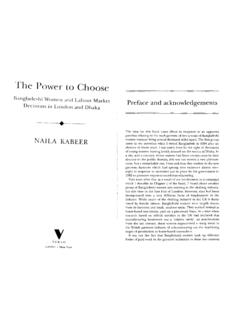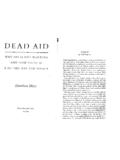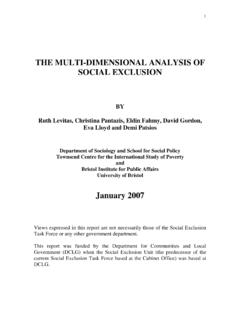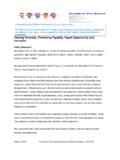Transcription of Villa Borsig Workshop Series 1999 Inclusion, …
1 Villa Borsig Workshop Series 1999 inclusion , justice , and Poverty ReductionAbsolute poverty, relative deprivation and social exclusion (1) by Fran ois Bourgignon(2) The title of this session, inclusion , Structural Inequality and Poverty: Interplay of Economic and Social Forces , clearly is an invitation to establish a bridge between a somewhat standard economic approach to poverty and inequality and a more sociological view at the relationship between these concepts and the notion of social inclusion . I am not sure that a hardcore economist is the best person to build such a bridge. But, we must start somewhere and a strict economic perspective may be as efficient a point of departure as a more multidisciplinary approach. Starting from the general concept of poverty, I would like to develop here three basic ideas which I believe permit identifying some of the links between poverty and inequality on the economic side, and the concept of social inclusion , on the sociological side.
2 They also point to research directions which have not yet been fully explored with enough care by economists as well as a new way of looking at policy issues in the field of poverty. The first idea refers to the distinction to be made between the concepts of absolute and relative poverty, which I will also often refer to in what follows as physical and social poverty or still relative deprivation . The second has to do with the duration of, and possibly intergenerational, endurance of poverty: that is, the lack of social mobility. The last point is concerned with the direct and indirect cost of relative poverty and low social mobility and the way these two phenomena, acting together, may be responsible for absolute poverty in developing countries. 1. Absolute poverty or social deprivation: food vs. linen shirt There has been a long debate in economics about whether income or consumption poverty lines should be defined in absolute or relative terms.
3 Most international organizations define the poverty line in an absolute way as the level of income necessary for people to buy the goods necessary to their survival. For instance the 1 dollar a day line - at 1985 purchasing power parity- has been extensively used ever since the 1990 World Development Report as the extreme poverty line in studies of the extent of poverty, its socio-demographic profile and its evolution in the world and in specific countries. Other analysts prefer defining the poverty line in relative terms as some proportion of the mean or the median income in the country under analysis. With such a definition some authors prefer then to refer to relative deprivation rather than poverty. However, no such semantic precaution is taken when the European Commission defines the European poor as all people whose consumption expenditures or income falls below 50 per cent of the mean in the country where they live.
4 These two concepts are far from equivalent. Even though they may well coincide at some point of time in a particular country, there is no reason they should continuously do so. Should we prefer one to the other? The debate on this issue has been going on for very long among economists see for instance Atkisnon (1998) or Ravallion (1992). It is not settled. However, there does not seem to be any strong reason why it should be settled in favor of one or the other alternative. Absolute and relative poverty concepts are simply aimed at describing and analyzing different issues. Physical poverty is about mere survival, that is the capacity to buy food and all the goods necessary for the fulfillment of basic physical needs. Relative poverty or social deprivation is about not being like others. This is the linen shirt argument that Sen (1983) borrowed from Adam Smith.
5 In 18th century England, a peasant unable to afford wearing a linen shirt would not participate to social events in his village, even though he and his family might not be undernourished. In this sense, poverty arises any time an individual cannot afford doing, or functioning in the words of Sen as most people do in the society he/she is living in. Social poverty or relative deprivation thus describes a social phenomenon which may be considered as very close to the more modern concept of social exclusion . By contrast, somebody who is physically or absolutely poor may not be socially excluded if most people he/she knows share the same condition. The two concepts are not exclusive. They simply describe different conditions and may in some instances call for different policies. If physical poverty is very widespread in a country, as it is the case in the poorest developing countries, growth-enhancing policies must probably be given high priority.
6 If physical poverty is less important but if social poverty and therefore social exclusion is found to be excessive, then redistribution policies, or possibly growth-cum-redistribution policies are called for. The development literature generally takes either one or the other point of view but rarely both. In particular, relative poverty is often found to be related to or synonymous of inequality and therefore of no primary relevance for actual , that is absolute poverty issues and policy. I do not see any reason why both concepts should not be considered simultaneously. There are countries in Africa and Asia where the dominant problem is absolute poverty and where social exclusion or relative deprivation is presently of lesser importance. But there are countries where both physical and social poverty are of concern, as in many parts of Latin America.
7 Too much priority given in the past to absolute poverty over relative deprivation, or equivalently social exclusion , may have contributed in some cases to inadequate policies. It is important to reestablish some parity between both points of view in all cases where this is justified.(3) 2. The dynamics of poverty: social exclusion as permanent poverty Poverty, absolute or relative, would not be a problem if it were known to be purely transitory, that is limited for all poor to very short periods of time. This means that the previous definition of physical poverty and social deprivation are insufficient. They must be made dynamic. In such a perspective, the link between poverty analysis and the concept of social exclusion appears still more clearly. With an temporal definition absolute poverty would correspond to a situation where an individual would remain permanently, or at least for a very long time, below some physical poverty line.
8 This might be for two reasons: limited income mobility and slow economic growth making more distant the prospect for poor people to cross the poverty line. It may be shown that such defining absolute poverty in terms of duration- how many people are below the poverty line and for how long - is not independent from the initial importance of relative deprivation, or more generally of inequality. Kakwani (1993) and Chen and Ravallion (1998) noted that under the assumption of a constant distribution of relative incomes and a constant rate of growth it would take more time to eradicate absolute poverty in a more in-egalitarian economy than in an economy with less relative deprivation. Taking a temporal point of view has more far-reaching consequences for social poverty. Permanent relative poverty is a situation where some individuals in society have simply no chance of ever having an income larger than some limited proportion of the mean or median income of society.
9 They are trapped in a low relative income position. The word chance used here may be given different meanings. It is unlikely that somebody may be structurally unlucky by drawing systematically bad numbers in a lottery. In other words, the point is not that some people in society are systematically affected by negative productivity shocks. The lack of chance behind the relative poverty trap may be due to less efforts being made to obtain what would be socially considered a more or less decent level of income. More importantly, however, it may result from a structural lack of opportunities. Even if individuals caught in a low relative income trap were making all possible efforts they would be unable to reduce the distance from typical living standard median or mean in the society they live in. In the terms of Sen, their capability set is simply not broad enough to permit them catching up.
10 In that sense they truly are socially excluded . They are not excluded because they cannot do today what other people usually do. They are excluded because there is no way they will ever be above the corresponding relative income poverty line no matter how much work or efforts they put into it. This will generally be because they inherited an unfavorable combination of skills. In some cases, this will be because they belong to some specific social group defined by race or ethnic origin that is discriminated against. But it will more often be because they were simply born from poor parents and due to several market imperfections, most noticeably credit-market imperfections, they did not have the same opportunities as children born in other social classes. The economic reasons for such a persistence of relative poverty, or more generally for the reproduction of inequalities, have received very much attention by economists over the last 10 years or so.

